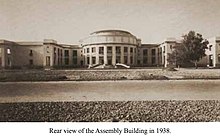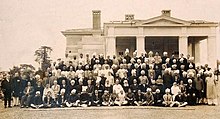Punjab Provincial Assembly (British India)
Punjab Provincial Assembly | |
|---|---|
| Type | |
| Type | |
Term limits | 5 years |
| History | |
| Founded | 5 April 1937 |
| Disbanded | 4 July 1947 |
| Preceded by | Punjab Legislative Council |
| Succeeded by |
|
| Leadership | |
Speaker | Shahab-ud-Din Virk (First) |
Sataya Prakash Singha (Last) | |
Deputy Speaker | Dasaundha Singh (First) |
Kapur Singh (Last) | |
Prime Minister | Sikandar Hayat Khan (First) |
Malik Khizar Hayat Tiwana (Last) | |
Leader of Opposition | Gopi Chand Bhargava (First) |
Iftikhar Hussain Khan Mamdot (Last) | |
| Seats | 175
|
| Elections | |
| First-past-the-post | |
First election | 1937 |
Last election | 1946 |
| Meeting place | |
| Lahore | |
| Constitution | |
| Government of India Act 1935 | |

The Punjab Provincial Assembly was the legislature of the province of Punjab in British India. Established by British authorities under Government of India Act 1935, the assembly had executive powers and members directly elected from 175 constituencies by first past the post system.
Speakers
| S. No. | Name | Tenure | Party | Assembly | ||
|---|---|---|---|---|---|---|
| 1 | Shahab-ud-Din Virk | 6 April 1937 | 16 March 1945 | Unionist Party | 1st | |
| 2 | Sataya Prakash Singha | 21 March 1946 | 4 July 1947 | 2nd | ||
Deputy Speakers
| S. No. | Name | Tenure | Party | Assembly | ||
|---|---|---|---|---|---|---|
| 1 | Dasaundha Singh | 6 April 1937 | 7 April 1941 | Unionist Party | 1st | |
| 2 | Gurbachan Singh | 22 April 1941 | 16 March 1945 | |||
| 3 | Kapur Singh | 26 March 1946 | 4 July 1947 | 2nd | ||
Prime minister
| S. No. | Name | Tenure | Party | Assembly | ||
|---|---|---|---|---|---|---|
| 1 | Sikandar Hayat Khan | 5 April 1937 | 26 December 1942 | Unionist Party | 1st | |
| 2 | Malik Khizar Hayat Tiwana | 30 December 1942 | 19 March 1945 | |||
| 21 March 1946 | 2 March 1947 | 2nd | ||||
Seats Distribution
All 175 constituencies were reserved on the bases of religion. It was as follows:-
| Constituency Type | Urban | Rural | Total |
|---|---|---|---|
| General | 8 | 34 | 42 |
| Muhammadans | 9 | 75 | 84 |
| Sikhs | 2 | 29 | 31 |
| Special^ | - | - | 18 |
| Total | 19 | 138 | 175 |
^Special constituencies (non-territory constituency) were further divided into Categories and sub-categories as follow:-
- Women - 4
- General - 1
- Mohammadans - 2
- Sikhs - 1
- European - 1
- Anglo-Indian - 1
- Indian Christian - 2
- Punjab Commerce and Industry - 1
- Landholders - 5
- General - 1
- Mohammadans - 3
- Sikhs - 1
- Trade and Labour Unions - 3
- University - 1
First Assembly

After the passing of Government of India act 1935, Provincial assembly was set up in Punjab. It consisted 175 constituencies. Out of these 159 were single-member constituencies and 8 were double-members constituencies. In double-members constituencies one was reserved for the Schedule Caste according to Poona Pact.[1] In double constituencies each voter had two votes to cast his vote, one for SC candidate and one for general candidate but considered as one vote to calculate voter turnout.
| Party | Seats won | |
|---|---|---|
| Unionist Party (UoP) |
98 | |
| Indian National Congress (INC) |
18 | |
| Khalsa National Party (KNP) |
13 | |
| Hindu Election Board (HEB) |
12 | |
| Shiromani Akali Dal (SAD) |
11 | |
| Majlis-e-Ahrar-ul-Islam (MAI) |
4 | |
| All-India Muslim League (AIML) |
2 | |
| Congress Nationalist Party (CNP) |
1 | |
| Independents (IND) |
16 | |
| Total | 175 | |
| Source:[2] | ||
Second Assembly
On the eve of the elections, the political landscape in the Punjab was finely poised, and the Muslim League offered a credible alternative to the Unionist Party. The transformation itself had been rapid, as most landlords and pirs had not switched allegiance until after 1944.[3] The breakdown of talks between the Punjab Premier, Malik Khizar Hayat Tiwana and Muhammad Ali Jinnah in late 1944 had meant many Muslims were now forced to choose between the two parties at the forthcoming election.[3] A further blow for the Unionists came with death of its leading statesman Sir Chhotu Ram in early 1945.
The Result of election was as follows:-[4]
| Party | Seats won | Change | |
|---|---|---|---|
| All-India Muslim League | 73 | ||
| Indian National Congress | 51 | ||
| Shiromani Akali Dal | 21 | ||
| Unionist Party | 19 | ||
| Independent | 11 | ||
| Others | 0 | ||
| Total | 175 | ||
References
- ^ Elections in Punjab 1920-1947 (Pdf),(p. 16), Book by Kirpal C. Yadav. Retrieved 7 May 2021.
- ^ Political Development and Political Parties in Punjan 1849-1948 (Pdf), (p. 74), Pakistan Journal of Social Science Vol. 29, No. 1 (June 2009) pp. 65-78. Retrieved 14 May 2021.
- ^ a b Talbot, I. A. (1980). "The 1946 Punjab Elections". Modern Asian Studies. 14 (1): 65–91. doi:10.1017/s0026749x00012178. JSTOR 312214. S2CID 145320008.
- ^ Political Development and Political Parties in Punjan 1849-1948 (Pdf), (p. 74), Pakistan Journal of Social Science Vol. 29, No. 1 (June 2009) pp. 65-78. Retrieved 14 May 2021.
